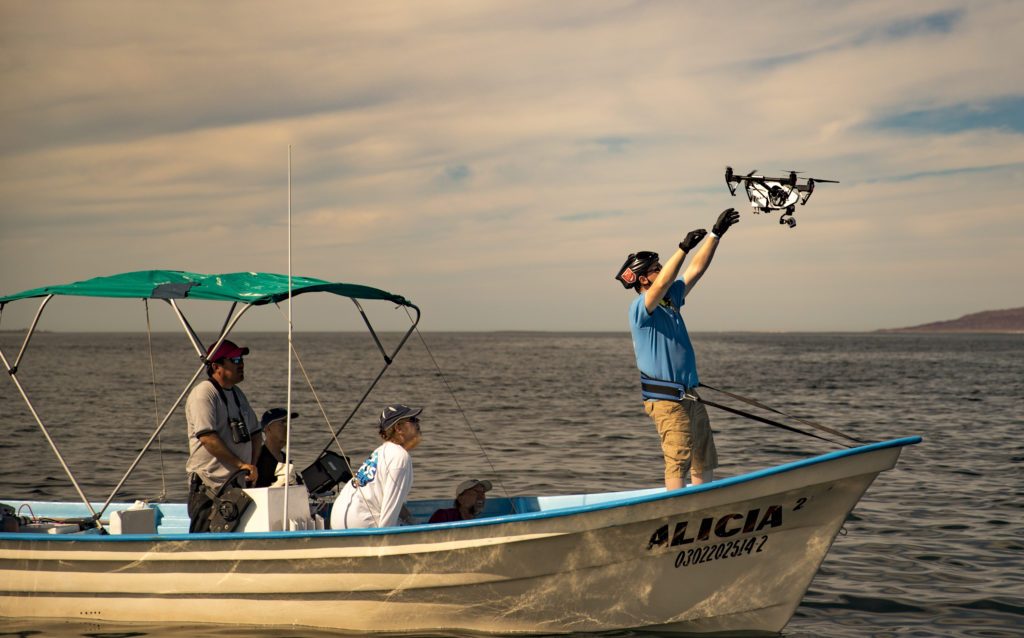Drones get a lot of credit for their pioneering potential across various industrial sectors. From inspection and maintenance to aerial photography and agriculture, there’s no end of use cases and excited adopters.
But, as we’ve written about before, the same technology is also revolutionizing the environmental sector.
Today in New York, as part of the United Nations’ Ocean Conference in celebration of World Oceans Day, Professor Iain Kerr, CEO of Ocean Alliance, spoke to a packed audience about his organization’s use of drone technology.
We’ve previously featured the SnotBot concept, Ocean Alliance’s fleet of adapted DJI Inspire drones. This was a chance for Kerr to show the potential of the idea to the watching world.

The most obvious use of drones in the world of marine conservation is the ability to get above what is being studied, not just alongside it. This is particularly handy when observing elusive mammals such as whales.

Comparing watching whales to observing land mammals, Kerr said: “I have a friend working in Africa,” said Kerr. “Every half an hour the elephant doesn’t disappear under the Serengeti and come up five miles away. As much as I’ve enjoyed this work it’s been frustrating.”
The second and third challenges faced when conducting whale research revolve around expense and the ‘observer effect’. First, traditional research vessels can cost in the region of millions of dollars. Second, the famous Heisenberg uncertainty principle highlights a problem that often occurs when studying animals in the wild: the very act of studying them changes their behaviour.

“The act of collecting data changes the data. So we need to come up with a new way of ocean monitoring that is affordable. With my team, we came up with a unique tool.”
“The other issue we’ve got as scientists is that we’re terrible communicators. I have some amazing friends [in the scientific community] that can make Indiana Jones boring! We have to make science interesting.”
Kerr then went on to reveal SnotBot to the crowd; a drone equipped with a petri dish capable of flying directly over whales as they come up for air and exhale a ‘blow’. That blow contains valuable data packed with biological information about the whales’ diets, habitats and more.
“We need this paradigm shift. It’s interesting to have been in this field for thirty years and then almost say to yourself, ‘I’ve been doing it wrong. Let’s do it a different way.'”

It’s clear that the use of drone technology has made a huge difference to the quantity and quality of data that Ocean Alliance is now able to gather. Kerr says, “This tool is as revolutionary as the microscope was to cellular biologists.”
On the one hand, drones are making marine conservation accessible to teams with much smaller budgets than before. On the other, they are now able to gather higher quality data. As well as not interfering directly with whales with a physical biopsy, aerial imaging offers an intimate view into behaviour while biological data is being collected.
Finally, Kerr is keen to point out that drone technology is an ideal way to get more people, particularly young scientists in the making, involved in marine conservation.
There are plenty of future plans in the pipeline for further uses of drone technology. We can’t wait to see what else the Ocean Alliance team has in store.
Malek Murison is a freelance writer and editor with a passion for tech trends and innovation. He handles product reviews, major releases and keeps an eye on the enthusiast market for DroneLife.
Email Malek
Twitter:@malekmurison
Subscribe to DroneLife here.







[…] Kerr, CEO of Ocean Alliance, has shown how his organization is using drone technology to improve the research, in a speech at the United Nations’ Ocean Conference in New York a […]